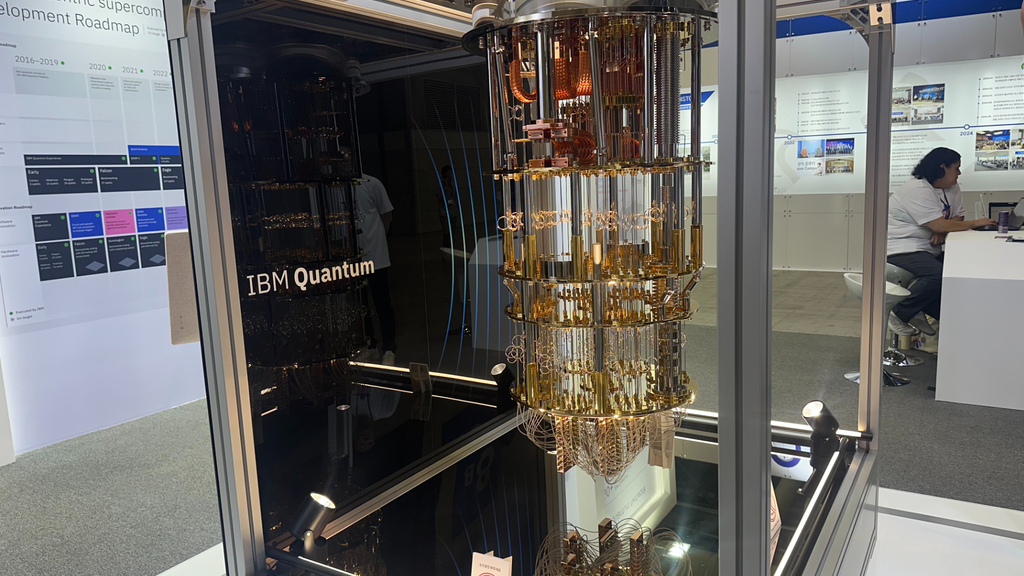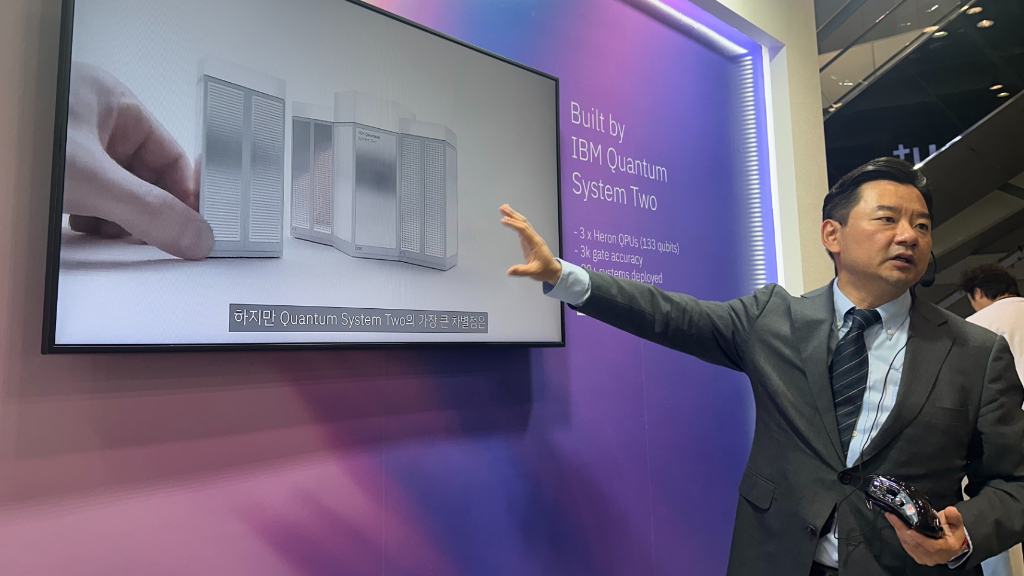과기정통부와 퀀텀코리아 2024 조직위원회 공동 주최 ‘퀀텀 코리아 2024’가 25일(화) 일산 킨텍스 제2전시장에서 개최됐다. IBM은 기존 컴퓨터로 해결하기 어려운 문제를 해결하기 위한 대규모의 양자 하드웨어 및 소프트웨어 개발 로드맵을 공개했다.
퀀텀코리아 2024 개최…양자퓨팅·양자암호 기술 대거 선
“韓 2035년까지 3조원 투자…양자 경제 달성 목표”
IBM, 양자 로드맵 발표...기존 대비 성능 5배↑ 헤론 칩 공개
양자 개발 소프트웨어 플랫폼 ‘퀴스킷’ 개발·배포
IBM이 기존 컴퓨터로 해결하기 어려운 문제를 해결하기 위한 대규모의 양자 하드웨어 및 소프트웨어 개발 로드맵을 공개했다. 차세대 컴퓨팅은 전통적인 컴퓨팅 방식과 양자 컴퓨팅이 공존하며 각 특화된 영역에서 시너지를 낼 것으로 전망되고 있다.
과기정통부와 퀀텀코리아 2024 조직위원회 공동 주최 ‘퀀텀 코리아 2024’가 25일(화) 일산 킨텍스 제2전시장에서 개최됐다. 우리나라는 12대 국가전략기술로 양자를 채택하고, 지난해 10월 양자기술산업법 제정으로 국가 양자 거버넌스를 구축 및 올해 4월 ‘퀀텀 이니셔티브’를 발표했다. 이는 올해 11월 이행될 것으로 기대된다.
과학기술정보통신부 양자과학기술산업과장 김연은 “국내 양자 산업의 주요 축은 양자 코어 기술 확보, 양자 엔지니어링, 양자 서비스 개발로, 정부는 2035년까지 최대 3조원의 인프라 투자 확대 계획과 인재 및 R&D 허브 육성에 집중할 것”이라고 설명했다. 또한 글로벌 협력을 바탕으로 산업을 확대해 양자 유니콘 기업을 세우고 2035년까지 양자 경제를 달성한다는 계획이다.
최근 양자 분야는 양자의 빠른 속도를 활용해 개발하는 컴퓨팅 기술과 양자의 불규칙성을 이용해 보안에 적용하는 축으로 개발되고 있다.
IBM은 양자 로드맵을 공개하고, 양자 컴퓨터를 비롯한 소프트웨어 기술을 대거 소개했다. IBM은 지난 2016년부터 양자 연구를 통해 자사의 연구소 및 데이터센터에 60개 이상 양자 컴퓨팅 시스템을 구축했다. 또한 전 세계 최초 클라우드로 일반인에게도 양자 컴퓨터를 공개해 온 바 있다.
IBM 표창희 상무는 “2023년에 출시된 127큐비트 IBM 퀀텀 ‘이글(Eagle)’ 프로세서를 활용하면 양자 시스템이 고전 양자역학 시뮬레이션을 넘어 화학, 물리학, 소재 분야에서 기존 컴퓨터로 계산하기 어려운 규모를 해결할 수 있음을 증명했다”고 말했다.
예컨대 금융 시장의 변화에 실시간 대응하거나, 정유 회사에서 날씨, 일정 등의 무수한 경우의 수가 존재할 때, 빠른 속도로 글로벌 유통 난제를 해결할 수 있다. 이는 마치 데이터를 학습 및 추론하는 인공지능(AI)의 엔진인 CPU·GPU와 같은 격으로, 슈퍼컴퓨터보다 훨씬 뛰어난 성능을 가진다. 국내에서도 자율주행, 신소재 개발, 배터리 산업, 시뮬레이션 등에 활용될 것으로 전망된다.
그러나 IBM은 GPU나 CPU를 양자 컴퓨팅, 즉 QPU(양자 처리 장치)가 대체할 수 있다고 보지 않았다. IBM 부스 담당자는 “양자 컴퓨팅과 전통적 컴퓨터가 서로 장점을 부각시켜 하이브리드로 공존하는 방향으로 개발하고 있다”며, “차세대 컴퓨팅은 각 컴퓨팅 성능이 특화된 영역에서 시너지 효과를 내는 것”이라고 설명했다.

IBM은 이날 부스에서 올해 하반기 연세대학교 국제캠퍼스에 설치를 앞둔 ‘양자 시스템 1’ 장비를 전시했다. 해당 장비는 단계별로 캔이 외벽을 커버해 -237도 극저온을 유지하는 방식이다.
특히 2023년 12월 출시된 IBM 퀀텀 ‘헤론(Heron)’ 프로세서는 4년에 걸쳐 만들어진 아키텍처 기반으로 이글 프로세서 대비 5배 향상된 오류 감서 및 높은 성능을 보인다. 이는 IBM 최초 모듈형 양자 컴퓨터인 ‘퀀텀 시스템 2’에 3개가 탑재된다. 해당 컴퓨터는 뉴욕 왓슨 연구소에 구축돼 있다.
IBM은 “작년까지 큐비트 수를 늘려가는 것에 집중했다면, 이제 속도와 성능 향상에 집중해 칩 자체를 병렬 구조로 붙여 칩 간의 집적도는 높이고 노이즈는 낮추는 방식을 연구하고 있다”고 말했다.
IBM은 헤론 칩의 아키텍처를 기반으로 2033년까지 양자 개발 로드맵을 연장하고, 향상된 게이트 운영을 통해 양자 컴퓨팅 품질을 향상시키겠다는 목표를 밝혔다. IBM 표창희 상무는 “IBM 시스템의 규모, 품질, 속도가 지속적으로 개선되면 더 큰 회로를 실행할 수 있다”며, “5천, 10만, 1억 게이트까지 목표하고 있다”고 밝혔다.
한편 IBM은 개발자의 양자 회로 구축 및 실행을 돕는 소프트웨어 개발 툴도 강조한다. 2023년 발표한 ‘퀴스킷(Qiskit)’은 오픈소스 양자 프로그래밍 소프트웨어로, 전 세계 60만명의 사용자에게 채택된 바 있다. 표 상무는 “최근에는 생성형 AI를 접목해 LLM(거대언어모델)을 기반으로 연산을 위한 코드를 자동 생성해 주는 솔루션도 개발했다”고 소개했다.
또한 “IBM은 글로벌 양자 네트워크를 구축해 250개의 정부, 기관, 대학의 회원사가 IBM 제품을 사용하고 있으며, 2023년 12월 한·미·일 학생 4만 명을 대상으로 양자 교육을 진행할 계획을 발표해 양자 교육에도 앞장서고 있다”고 말했다. IBM의 39개 퀀텀 이노베이션 센터(QIC)는 허브 역할을 수행하며 글로벌 협력을 기반으로 연구 및 교육을 수행하고 있다.

